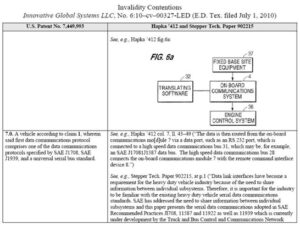Claim mapping of patent claims is a technical process used to map one or more claims of a patent to a specific feature, function, component or product featured by the patent to determine if any product or service is allegedly infringing the claims of the patent.
Purpose of Claim Mapping
The primary purpose of a claim map is to determine the occurrence of any form of patent infringement. The patent claim map is generally used during patent infringement analysis, where the claim map provides a clear visualization of all the information analysed in the patent claim.
The claims maps illustrate the infringement of each and every element of the claims of a patent by any existing product or service. The patent claim is infringed when each and every element or component of the patent claim is present in any product or service. It is highly important to interpret the patent claim to determine the patent infringement.
The patent claim mapping process evaluates and identifies the most important patents in a company’s patent portfolio and the level of protection provided by those patents. Claim mapping is highly important during the patent prosecution phase as it is critical to know which claims of the patent need to be retained and which are to be abandoned.
Structure of a Claim map
A claim map is generally a map having a textual and graphical comparison of the claims of a patent and the potentially infringing uses. The claim map may be created by manual examination of the claims, which is time consuming and labour-intensive process. Further, one can use various software tools for examining the claims, which is more efficient and effective than manual examination. The examined claims are used to create the claim map in different forms.
The claim map may be constructed in various forms, such as a map with two columns where the elements of a patent claim and the features of the potentially infringing products or services are mapped along with the related evidence. The claim map may be constructed in three-column forms where the elements of a patent claim, along with supporting citations from the specification of the patent providing interpretations of one or more of the elements of the claim are mapped with the potentially infringing products or services. Further, the claim map can be created in a graphical format where the examined claims are presented on different slides, each focusing on one claim element or a component. The claim maps demonstrate the probable infringement to a patent claim and target to map all the elements of the patent claim to complete the mapping.
Example of a Claim Map

Courtesy: https://www.linkedin.com/pulse/why-claim-charts-underlying-purposes-policies-local-patent-schulman/
Important considerations before mapping the claims
There are several points to be considered before mapping the patent claims. It is important for a claim map to address how the potentially infringing product or service carries out the claim limitation of the patent claim. Also, finding the individual or entity that infringes the patent is critical. In case any wrong individual or entity is accused of infringement, it might lead to unfavorable situations. The claim map must clearly define the infringer along with how or when that infringement has occurred.
Further, it is important not to map inconsequential products as mapping incorrect products may lead to nullifying the claim map. Additionally, while determining the potential infringer and their infringing product or service, care must be taken to map the most significant infringing products or services out of all the infringers. Also, it is critical to include all the evidence in the claim map for a stronger case. Further, it is important to make sure that all relevant evidence present in the claim map is supported by citations.
Conclusion
Claim mapping determines the probability of any form of infringement of a patent by creating a clear visualization of all the similarities between the elements present in a patent claim with potentially infringing products or services. It is important to address a claim’s limitations or requirements in the claim map before concluding that a claim is being infringed. A thoughtfully mapped patent claim map creates valuable intellectual property and facilitates the determination of claims to be retained and abandoned.
Author: Megha S Nadiger, Origiin IP Solutions LLP
Please contact us at info@origiin.com to know more about our services (Patent, Trademark, Copyright, Contract, IP Licensing, M&A of companies)
Subscribe to YouTube Channel HERE
Join LinkedIn Group: Innovation & IPR
WhatsApp: +91 74838 06607




